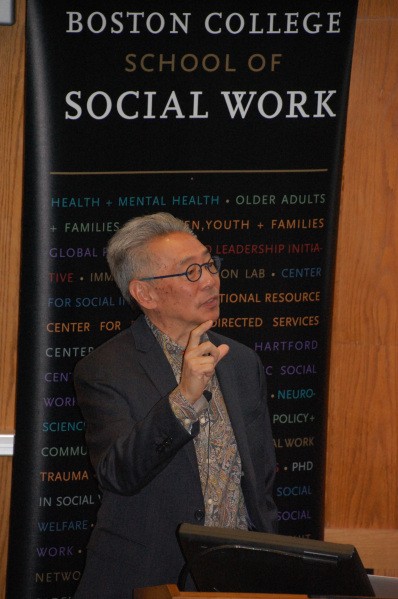
Michael Omi
In his book Blinded by Sight, UC-Hastings Law Professor Osagie Obasogie addresses one of the most fundamental imperfections in human understanding of race: that it is based almost entirely on visual cues such as skin color. The remarkable work focuses on how the blind “see race,” finding that even those who cannot see think about race from a visual perspective.
“In many respects, Blinded by Sight is really two books in one,” said UC-Berkeley Professor Michael Omi, in a recent talk at BCSSW. “It provides this empirical study about how people who have been blind since birth understand race and racism, and how the concept of race as visually self-evident distorts some of the laws, practices and policies ostensibly dealing with racial discrimination.”
Blinded by Sight presents an intriguing entrée into a conversation about how race is defined in public life, versus what race actually means to the men and women living in countless diverse communities across the globe. There is a clear disconnect between how policy has evolved, and the complexities of how we identify ourselves and others. Unfortunately, this disconnect often leads to racist ideology and practice.
The good news is, there are academics in America challenging us to think about these complexities, and in particular, there is Michael Omi.
On November 9, BCSSW was lucky enough to hear one of the pioneers in racial theory speak about the third edition of his groundbreaking and classic book Racial Formation in the United States. In short, Omi’s work defined racial formation as “the socio-historical process of race-making” a process fundamentally based on characterizing people as “other” and it explained that race and racism are flexible, contested, and unstable concepts. First published in 1986, but substantially revised and re-released this year, the book provides a transformative venue for understanding the social construction and politics of race.
During the event, in McGuinn Hall, Omi discussed what’s new in the new edition, and he reflected on potential future trends in racial theory. “What’s new” was a lot – Omi and co-author Howard Winant re-wrote every chapter of the book for this latest release in order to provide important updates that reflect our changing world and the realities of today’s America. Omi characterized the book’s updates in terms of five key themes that they have sought to address:
- Race as a master category – that race in the U.S. has served as a kind of template of both difference and inequality.
- A renewed focus on the continuing instability of the race concept itself.
- The racial ideology of colorblindness is far from realized despite certain popular scholarship suggesting that it has been; that we are far from living in a “post-racial” society.
- There remains an emphasis on the corporeal dimensions of race, and that implicit biases around race often are hardwired into our biology, and specifically, into how our brain processes what we see.
- Neoliberalism as a racial project – race still matters and it matters more than ever.
During his talk, Omi also asked the audience to ponder what the future in racial theory might look like, drawing from contemporary examples that challenge our existing understandings of race. He discussed Rachel Dolezal’s unintended foray into a very public spotlight, as well as the changing dynamics of the American population and how the U.S. Census report struggles to capture the racial and ethnic identities of so many of its citizens. (In fact, the Census Bureau is considering new questions for the 2020 Census that will eliminate the Hispanic/Latino ethnicity category and make it a racial one). And he cited the words of geneticist J. Craig Ventner, the first American to sequence the human genome, in reference to a project the scientist completed comparing the genomes of five individuals of different races: “What we’ve shown is that the concept of race has no [genetic] scientific basis.”
Still, explained Omi, while race is fluid, and increasingly difficult to succinctly define, it is imperative that we continue to try to do so. “In a racially stratified society,” he said, “…social concepts of race continue to matter.”
Listen to Omi’s BCSSW talk (with Powerpoint slides) in its entirety on our YouTube channel. And to learn more about the latest edition of Racial Formation in the United States check out these short reviews of the book from four current BCSSW doctoral students.

